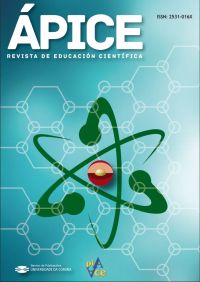Promoting the positive emotional change towards sciences, in the initial teacher training
Main Article Content
Abstract
The aim of this work is to identify the emotions of the future teachers (FM) towards physics and chemistry, as well as look for evidences of their modification throughout the context of the subject ‘Didactics of Matter, Energy and Interaction (DMEI). The responses of a questionnaire passed to the FM about their emotions before and after coursing the subject show a remarkable modification of negative emotions towards positive emotions. These changes are related to the methodology implemented in the subject, specifically with the experimental character that it has. The results also suggest the challenge that the FM value the importance of the emotional aspects of the learning, as well as to give sense to the knowledge they learn.
Keywords:
Downloads
Article Details
References
Appleton, K. (1995). Student teachers’ confidence to teach science: is more science knowledge necessary to improve self‐confidence? International Journal of Science Education, 17(3), 357-369. DOI: https://doi.org/10.1080/0950069950170307
Borrachero Cortés, A. (2015). Las emociones en la enseñanza y el aprendizaje de las ciencias en Educación Secundaria. Tesis doctoral. Universidad de Extremadura. Recuperado de: http://dehesa.unex.es/handle/10662/3066
Cañal, P. (2000). El conocimiento profesional sobre las ciencias y la alfabetización científica en primaria. Alambique, 24, 46-56.
Dávila Acedo, M. A., Cañada Cañada, F., Sánchez Martín, J., y Mellado Jiménez, V. (2016). Las emociones en el aprendizaje de física y química en educación secundaria. Causas relacionadas con el estudiante. Educación química, 27(3), 217-225. DOI: https://doi.org/10.1016/j.eq.2016.04.001
Gess-Newsome, J. (2002). Secondary Teachers’ Knowledge and Beliefs about Subject Matter and their Impact on Instruction. En J. Gess-Newsome & N. G. Lederman (Eds.), Examining Pedagogical Content Knowledge (Vol. 6). Dordrecht: Kluwer Academic Publishers. Recuperado de: http://www.springerlink.com/content/j66t4t4m510021u3/
Harlen, W., y Holroyd, C. (1997). Primary teachers’ understanding of concepts of science: impact on confidence and teaching. International Journal of Science Education, 19(1), 93-105. DOI: https://doi.org/10.1080/0950069970190107
Hollon, R., Roth, K., & Anderson, C. (1991). Science teachers’ conceptions of teaching and learning. En Brhopy, J. (Ed.), Advances in research on teaching (Vol. 2, pp. 145-186). Greenwich (CT): JAI Press.
Hugo, D. V. H., Sanmartí, N., & Adúriz-Bravo, A. (2013). Estilos de trabajo emocional del futuro profesorado de ciencias durante el practicum. Enseñanza de las ciencias: revista de investigación y experiencias didácticas, 31(1). DOI: https://doi.org/10.5565/rev/ec/v31n1.606
Mega, C., Ronconi, L., & De Beni, R. (2014). What makes a good student? How emotions, self-regulated learning, and motivation contribute to academic achievement. Journal of Educational Psychology, 106(1), 121-131. DOI: https://doi.org/10.1037/a0033546
Mellado, V. (2003). Cambio didáctico del profesorado de ciencias experimentales y filosofía de la ciencia. Enseñanza de las Ciencias, 21(3).
Mellado, V. M., Borrachero, A. B., Brígido, M., Melo, L. V., Dávila, M. A., Cañada, F., & Al, E. (2014). Las emociones en la enseñanza de las ciencias. Enseñanza de las ciencias: revista de investigación y experiencias didácticas, 32(3), 11-36. DOI: https://doi.org/10.5565/rev/ensciencias.1478
Murphy, C., & Beggs, J. (2003). Children’s perceptions of school science. School Science Review Number 308 - The Association for Science Education, 84(308), 109-116.
Osborne, J., Driver, R., & Simon, S. (1998). Attitudes To Science: Issues and Concerns. School Science Review, 79(288), 27-33.
Parkinson, J., Hendley, D., Tanner, H., & Stables, A. (1998). Pupils’ Attitudes to Science in Key Stage 3 of the National Curriculum: a study of pupils in South Wales. Research in Science & Technological Education, 16(2), 165-176. DOI: https://doi.org/10.1080/0263514980160206
Pérez Serrano, G. (1994). Investigación cualitativa. Retos e interrogantes I Métodos. Madrid: La Muralla.
Pipitone, C., LLadó, À. G., Mas, J. G., Mingo, A. C. de, Carvajal, I. M., Agudelo, C., & Hernández, E. M. (2016). Actividades dialógicas de ciencias en la formación inicial del profesorado de educación primaria Dialogical activities of science in the initial teacher training of Primary Education. Campo Abierto. Revista de Educación, 35(1), 93-108.
Ramsden, J. M. (1998). Mission impossible?: Can anything be done about attitudes to science? International Journal of Science Education, 20(2), 125-137.DOI: https://doi.org/10.1080/0950069980200201
Shapiro, S. (2010). Revisiting the teachers’ lounge: Reflections on emotional experience and teacher identity. Teaching and Teacher Education, 26(3), 616-621.
Talanquer, V. (2004). Formación docente: ¿Qué conocimiento distingue a los buenos maestros de química? Educación química, 15(1), 52-58.
Tesch, R. (1990). Qualitative Research: Analysis Types and Software Tools. New York: Falmer Press.
Vázquez Alonso, Á., & Manassero–Mas, M. A. (2008). El declive de las actitudes hacia la ciencia de los estudiantes: un indicador inquietante para la educación científica. Revista Eureka sobre Enseñanza y Divulgación de las Ciencias - 2008, 5(3) pp. 274-292. Recuperado de: http://rodin.uca.es:80/xmlui/handle/10498/10314
Zembylas, M. (2001). Constructing genealogies of teachers’ emotions in science teaching - Zembylas - 2001 - - Wiley Online Library. Journal of Research in Science Teaching, (39), 79–103. DOI: https://doi.org/10.1002/tea.10010
Zembylas, M. (2003). Emotions and Teacher Identity: A poststructural perspective. Teachers and Teaching, 9(3), 213-238. DOI: https://doi.org/10.1080/13540600309378



